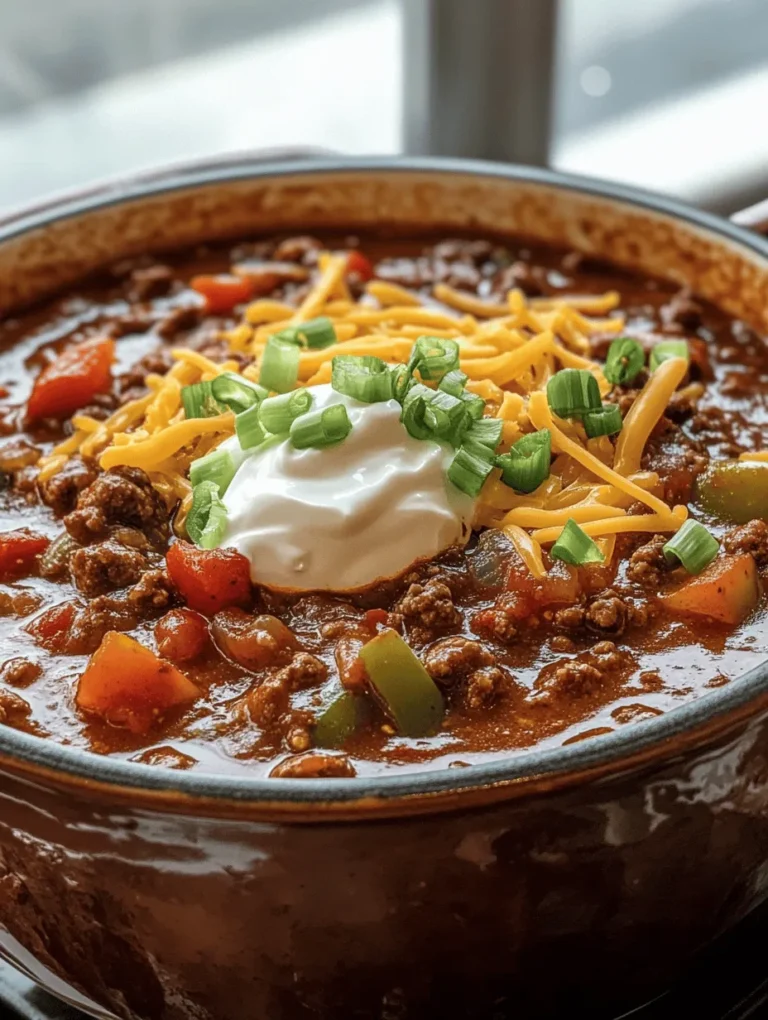Introduction
Chili is more than just a dish; it’s a beloved comfort food that has nestled itself into the hearts and homes of many. Known for its hearty flavors and warm spices, chili often evokes memories of family gatherings, tailgate parties, and cozy evenings by the fire. Its versatility allows for a wide range of variations, making it a favorite for both traditionalists and culinary adventurers alike. In this article, we will explore an easy, delicious, and customizable chili recipe that you can whip up in no time, ensuring that you always have a go-to meal ready for any occasion.
Homemade chili stands out for its ability to bring people together. Whether it’s a chilly autumn evening or a summer barbecue, a pot of steaming chili can set the perfect atmosphere. The satisfaction of creating a dish from scratch—tailoring it to your preferences and dietary needs—makes all the difference. In this recipe, we will focus on creating an ultimate easy homemade chili that can be adapted to suit your taste, whether you prefer a spicy kick or a milder flavor.
Understanding the Appeal of Homemade Chili
Chili has a rich history that spans cultures and continents. Its origins can be traced back to the American Southwest, where it evolved from a blend of Native American, Spanish, and Mexican culinary traditions. The dish has become an iconic representation of regional cooking, particularly in states like Texas, where chili competitions and festivals celebrate this hearty stew.
One of the most significant advantages of making chili at home is that you have complete control over the ingredients. Store-bought chili can often contain preservatives, additives, and other unwanted ingredients that compromise its quality and flavor. By preparing chili from scratch, you ensure that every component is fresh and tailored to your liking. This not only enhances the nutritional value of the meal but also allows you to experiment with flavors and textures that store-bought options simply can’t replicate.
Homemade chili also provides the opportunity to cater to specific dietary preferences. Whether you want to reduce fat content, increase fiber by adding more beans, or go meatless altogether, making chili at home allows you to make these adjustments without compromising taste. Additionally, the communal aspect of preparing chili can turn a simple cooking task into a family affair, where everyone can contribute their ideas and flavors to the pot.
Ingredients Breakdown
Creating the perfect chili begins with understanding the key components that contribute to its rich flavor and satisfying texture. Below, we break down the essential ingredients that make up our ultimate easy homemade chili:
Ground Beef vs. Turkey: Nutritional Comparisons and Flavor Profiles
When it comes to the meat base of your chili, the choice between ground beef and ground turkey often comes down to personal preference and nutritional considerations. Ground beef is renowned for its rich flavor and hearty texture, making it a traditional choice for classic chili recipes. However, it can be higher in fat, particularly if you opt for cuts that are not lean.
On the other hand, ground turkey presents a healthier alternative with a lower fat content, making it ideal for those seeking a lighter version. While turkey may have a milder flavor compared to beef, it absorbs spices and seasonings exceptionally well, allowing for a flavorful dish that still satisfies. Ultimately, whether you choose beef or turkey, both options can create a delicious base for your chili.
The Role of Beans in Chili: Kidney Beans and Black Beans Explained
Beans are a staple in many chili recipes, not only for their nutritional benefits but also for their ability to add texture and bulk. Kidney beans are commonly used due to their firm texture and ability to hold up during cooking. They soak up the flavors of the chili, providing a satisfying bite with each spoonful. Black beans, on the other hand, bring a slightly sweet, earthy flavor that complements the other ingredients, adding depth to the dish.
Incorporating beans into your chili not only enhances its heartiness but also boosts the fiber and protein content, making it a more balanced meal. Whether you prefer one type of bean or a mix, both will add a delightful creaminess to the final dish.
Importance of Aromatics: Onions and Garlic
Aromatics are the foundation of flavor in any savory dish, and chili is no exception. Onions and garlic are essential components that provide a robust base for the recipe. Onions, when sautéed, release natural sugars that caramelize and enhance the overall taste, while garlic adds a distinctive aromatic quality that elevates the dish.
For the best results, consider using yellow onions for their sweetness or red onions for a sharper flavor. When it comes to garlic, fresh cloves will always yield the most potent flavor, but if you’re in a pinch, garlic powder can serve as a suitable substitute.
The Impact of Tomatoes and Tomato Sauce on Chili Texture and Flavor
Tomatoes play a pivotal role in chili, contributing both acidity and sweetness that balance the richness of the meat and beans. Whether you opt for diced tomatoes, crushed tomatoes, or tomato sauce, each will impart its unique flavor and texture to the dish. Diced tomatoes add chunks and a fresh quality, while crushed tomatoes create a smoother base that thickens the chili beautifully.
Additionally, tomato paste can be used to deepen the tomato flavor and enhance the overall richness of the dish. The key is to find the right balance between the tomato components to achieve your desired chili consistency.
Spice Profiles: How Chili Powder, Cumin, and Other Spices Enhance the Dish
Spices are what truly bring chili to life, providing warmth and complexity to the dish. The star of the show is undoubtedly chili powder, which can vary in heat and flavor depending on the blend. Common ingredients in chili powder include dried chilies, cumin, and garlic powder. If you enjoy a spicier kick, consider adding cayenne pepper or crushed red pepper flakes to the mix.
Cumin is another essential spice in chili, adding an earthy and slightly smoky flavor that complements the other ingredients beautifully. Other spices, such as paprika and oregano, can also enhance the overall profile, allowing you to tailor the heat and flavor to your liking.
Optional Toppings: Enhancing Flavor and Presentation
While the chili itself is the star of the meal, toppings can elevate the experience to a whole new level. Consider offering a variety of toppings for your chili, including shredded cheese, sour cream, chopped green onions, or fresh cilantro. These toppings not only add visual appeal but also introduce different textures and flavors that enhance each bite.
For those who enjoy a bit of crunch, tortilla chips or cornbread served alongside can provide a delightful contrast to the smoothness of the chili. Don’t be afraid to customize your toppings based on personal preference—this is where your creativity can shine!
Preparation Steps for Ultimate Easy Homemade Chili
Now that we’ve covered the essential ingredients that make up our ultimate chili, it’s time to dive into the preparation steps that will lead to a delicious and satisfying dish.
Sautéing the Aromatics: Techniques for the Best Flavor Extraction
The first step in creating your chili is to sauté the aromatics. Start by heating a large pot or Dutch oven over medium heat and adding a splash of oil. Once the oil is shimmering, add your chopped onions and cook for about 5-7 minutes, stirring occasionally, until they become translucent and fragrant. This process allows the natural sugars in the onion to caramelize, creating a sweet foundation for your chili.
Next, add minced garlic to the pot. Garlic cooks quickly, so sauté it for just 1-2 minutes until it becomes fragrant; be careful not to let it burn, as this can impart a bitter taste. This careful sautéing technique is essential for extracting the maximum flavor from your aromatics and setting the stage for the rest of your ingredients.
Browning the Meat: Importance of Browning for Depth of Flavor
After your aromatics are beautifully sautéed, it’s time to add your choice of ground meat. Increase the heat to medium-high and add the ground beef or turkey to the pot. As the meat cooks, use a wooden spoon to break it up into smaller pieces, ensuring even cooking.
The key to achieving a rich and flavorful chili is to brown the meat thoroughly. This process not only enhances the flavor through the Maillard reaction but also contributes to the overall texture of the dish. Allow the meat to cook without stirring too frequently, giving it time to develop a nice brown crust. This should take about 5-7 minutes.
Once the meat is browned, it’s time to move forward with the next steps in this ultimate easy homemade chili recipe, where we will incorporate the remaining ingredients and allow the flavors to meld beautifully. Stay tuned for the continuation of this mouthwatering journey!
Adding Beans and Tomatoes
Incorporating beans and tomatoes into your chili is essential for creating that hearty texture and rich flavor profile we all crave. When adding beans, whether you prefer kidney beans, black beans, or pinto beans, it’s important to rinse them thoroughly if you’re using canned varieties. This helps remove excess sodium and any unwanted flavors. For dried beans, ensure they are pre-soaked and cooked before adding them to the chili pot.
As for tomatoes, you can opt for diced tomatoes, crushed tomatoes, or even tomato sauce depending on your preference for consistency. When adding these ingredients, pour them in after your meat has browned and the onions and garlic have softened. This timing allows the tomatoes to meld with the spices and meat juices, enriching the overall flavor of the chili. Stir everything together, making sure your beans and tomatoes are well-distributed throughout the mixture, and watch as they absorb the spices and blend harmoniously.
Seasoning the Chili
Seasoning is the heart of any chili recipe, and striking the right balance can elevate your dish from good to great. Start with the basics: salt, pepper, and a pinch of sugar. The sugar helps to balance the acidity from the tomatoes. From there, layer in your spices. Chili powder is a must, but consider adding cumin for warmth, smoked paprika for depth, and even cayenne pepper for a kick.
Taste as you go! This is key to ensuring your chili has the right flavor profile for your palate. If you prefer it spicier, feel free to add more cayenne or even some chopped fresh jalapeños. Conversely, if you find it too hot, you can dilute the heat by adding more beans or tomatoes. Remember to let the flavors meld for a bit before making final adjustments, as some spices may take a little time to fully develop.
Simmering for Flavor Development
Simmering is where the magic happens in your chili. Allowing your chili to simmer for at least 30 minutes—preferably an hour or more—allows flavors to meld and deepen, creating a robust dish that’s bursting with flavor. The longer you simmer, the thicker the chili will become, as the liquid reduces and the flavors intensify.
If you’re short on time, a minimum of 20 minutes will still yield a tasty chili, but for those who can wait, consider simmering for up to two hours. Keep the pot covered to maintain moisture, and stir occasionally to prevent sticking. If you notice the chili getting too thick, simply add a splash of broth or water to adjust the consistency to your liking.
Tasting and Adjusting
The final seasoning of your homemade chili is an art. After simmering, take a moment to taste your creation. Assess the balance of flavors—are the spices pronounced? Is there enough salt? Does the acidity from the tomatoes need to be toned down? This is your opportunity to personalize the recipe.
If you find that your chili lacks depth, consider a splash of lime juice or a dash of vinegar to brighten the flavors. For an added layer of richness, a spoonful of cocoa powder or a small amount of dark chocolate can work wonders, enhancing the overall taste without making it sweet.
Cooking Methods for Chili
When it comes to cooking chili, there are several methods to choose from, each boasting its own set of advantages.
Stovetop
Cooking chili on the stovetop is the most traditional method and allows for the quickest results. It’s perfect for those who want to whip up a batch in under an hour. The stovetop method gives you complete control over the cooking process, allowing you to adjust heat levels and seasoning as needed.
Cooking Time: Approximately 1 hour, depending on your simmering time.
Slow Cooker
The slow cooker is ideal for those who prefer a hands-off approach. Simply combine all your ingredients in the pot, set it to low, and let it cook for 6 to 8 hours. This method develops flavors beautifully, as the long, slow cooking allows spices to infuse deeply into the meat and beans.
Cooking Time: 6 to 8 hours on low, or 3 to 4 hours on high.
Instant Pot
For those pressed for time but still craving rich flavors, the Instant Pot is a game-changer. It allows you to brown your meat and sauté vegetables directly in the pot, then cook the chili under pressure, drastically reducing cooking time.
Cooking Time: About 30 minutes, including the time to come to pressure.
Tips for Meal Prepping and Storing Leftover Chili
Chili is a fantastic candidate for meal prep, as it freezes and reheats exceptionally well. To store leftover chili, allow it to cool completely before transferring it to airtight containers. It can be kept in the refrigerator for up to 4 days or frozen for up to 3 months.
When reheating, add a splash of broth to help restore the original consistency, as chili tends to thicken in the fridge. If you’re meal prepping for the week, consider portioning out individual servings to make lunchtime even easier.
Health Considerations
Homemade chili is not only comforting and delicious, but it also comes with a host of nutritional benefits. Packed with protein from the beans and meat, it can be a nutrient-rich meal that satisfies hunger.
If you’re looking to adjust the recipe for dietary restrictions, there are a few simple swaps you can make:
– Gluten-Free: Ensure any sauces or spices you use are labeled gluten-free.
– Vegetarian/Vegan: Substitute the meat with additional beans or lentils, and use vegetable broth instead of beef broth.
– Low-Fat: Choose lean cuts of meat, such as ground turkey or chicken, and limit added oils.
To reduce calories without sacrificing flavor, consider using spices liberally, as they can enhance taste without added fat or sugar.
Serving Suggestions and Pairings
To elevate your chili experience, consider pairing it with complementary sides. Cornbread is a classic choice, providing a sweet contrast to the spicy chili. Rice can also serve as a hearty base, soaking up the flavorful sauce.
For beverages, a cold beer often pairs well with the robust flavors of chili, while a light, crisp white wine can cut through the richness. If you prefer non-alcoholic options, consider serving chili with a refreshing iced tea or lemonade.
For a fun twist during gatherings, serve chili in mini bread bowls, or create a chili bar with toppings like sour cream, shredded cheese, green onions, and diced avocado. This allows guests to customize their bowls and adds a festive touch to your meal.
Conclusion
Making homemade chili is not just a cooking endeavor; it’s an invitation to explore flavors, experiment with ingredients, and enjoy the satisfaction of crafting a comforting dish from scratch. With its simplicity and versatility, this ultimate easy homemade chili recipe is bound to become a favorite in your kitchen.
We encourage you to try this recipe and make it your own by adjusting spices, adding your favorite beans, or tweaking the heat level. Share your experiences, variations, and any tips you discover in the comments below. Happy cooking!



